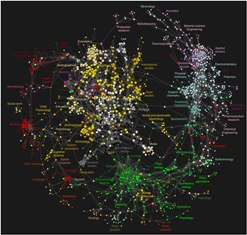A realistic map of scientific thought
 Tracking citation data (i.e., which papers cite which other papers) has traditionally been the method for understanding the interconnectivity of different fields and subfields of research. But in the age when most researchers access their information online, the printed word can sometimes be years out of date.
Tracking citation data (i.e., which papers cite which other papers) has traditionally been the method for understanding the interconnectivity of different fields and subfields of research. But in the age when most researchers access their information online, the printed word can sometimes be years out of date.
In a paper published this week in Public Library of Science ONE (PLoS ONE), Johan Bollen of the Los Alamos National Laboratory and his colleagues created a digital map of scientific thought by assessing internet information access from a host of universities, publishers and internet aggregators. The data they compiled represented almost a billion online information requests.
![]() The map (click above) shows the different fields represented in a color gradient, with journals represented by dots clustered into subfields — most dots are not labeled, but they correspond to a colored field label. Larger dots are relatively more influential journals. Lines connecting the journals represent relationship strength: the shorter the line, the more closely related the material in the pair of journals.
The map (click above) shows the different fields represented in a color gradient, with journals represented by dots clustered into subfields — most dots are not labeled, but they correspond to a colored field label. Larger dots are relatively more influential journals. Lines connecting the journals represent relationship strength: the shorter the line, the more closely related the material in the pair of journals.
A few interesting results can be gleaned from this map. First, as the authors point out, the map shows a relatively large representation of social science information, a trend not normally depicted in citation data. The map can also be a useful tool to see the relationships emerging between various scientific subfields (such as the seemingly unlikely relationship between organic chemistry and international studies) and thus help researchers explore interdisciplinary relationships.
As the authors put it, “There can exist stark differences between what people claim they do and what they actually do.” In the case of citations, the authors make the distinction of the former as “a public and explicit expression of influence by scholarly authors,” whereas the latter represents the “private navigation behavior of scholarly users of web portals.” The act of citing a seminal or classic paper out of habit or duty and neglecting to cite more controversial or volatile published work might skew the representation of actual information transfer within the sciences. This map, the authors say, “offers a first-ever glimpse of this scholarly terra incognita.”
Read the open-access article here.
Bollen, J., Van de Sompel, H., Hagberg, A., Bettencourt, L., Chute, R., Rodriguez, M., & Balakireva, L. (2009). Clickstream Data Yields High-Resolution Maps of Science PLoS ONE, 4 (3) DOI: 10.1371/journal.pone.0004803